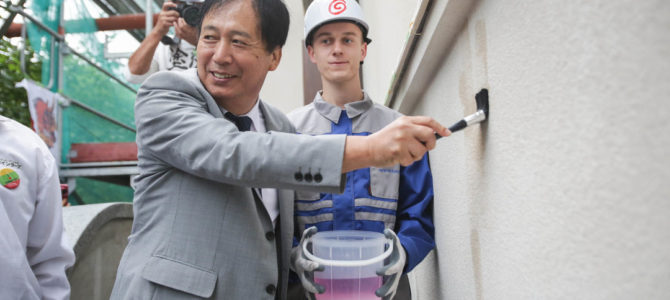
Kaunas, September 4, BNS–A group of painters dressed in white just arrived from Japan gathered at the residence and now museum of famous interwar Japanese diplomat and Righteous Gentile Chiune Sugihara Monday to help in the renovation of the building.
Tokon International chairman Keiichi Yasuda, whose company sent the painters, told BNS the painters wanted to help and make people happy.
“There are many companies which do everything for money, but money doesn’t bring happiness, the meaning of life is not money, but happiness, and we wanted to do something to help make people happy,” Mr. Yasuda said.
The painters won’t just paint the building over the course of a week. They also organized a benefit campaign in Japan and brought with them 30,000 euros for reconstruction of the museum.
“In Japan everyone knows Sugihara and everyone knows the Sugihara museum, it is very famous. We announced on the internet we were collecting funds for the restoration and all sorts of different people donated money,” the Japanese visitor said. Tokon painters are professionals in their field who have joined together to work for the public good. Originally they operated only in Japan but have now branched out to include projects in other countries.
“All of these people are painters and all of them are directors of paint companies of different sizes. Since they are directors, they can pay their own salaries,” Mr. Yasuda joked, adding they do try to pay the workers for their efforts.
“We wouldn’t be able to do this kind of charity work if we didn’t work at our own companies. We mainly work our normal work at our companies, and when we save up enough money, we can also do this sort of charity work. It won’t be easy to paint Sugihara House. We want the work done to last for a long time, so that will require significant effort,” Mr. Yasuda said.
Sugihara Foundation chairman Ramūnas Garbaravičius said the Japanese contribution to refurbishing the museum is also important in setting an example encouraging others to contribute to the effort.
“They donated 30,000 euros, and it’s difficult to put a price on their work. In any case it has sent out a wave and other people have begun donating. The total cost of renovation will be more than 100,000 euros, which isn’t much in terms of bookkeeping, but it really is a lot because it will carry with it all sorts of consequences,” Garbaravičius told BNS.
Mrs. Michi Sugihara, the wife of Chiune Sugihara’s eldest son, also attended the ceremony on Monday and recalled her first visit to Kaunas to the residents of the house which is now the museum.
“I visited here the first time with Mrs. Jukiko Sugihara more than a dozen years ago. At the time this place was very quiet and calm. At that time four families lived in this house, it was a residential house. Now I am very proud this house has its old look back and has become a bridge between two peoples. I didn’t hear directly from Chiune Sugihara what happened here, but I heard about it from his wife Jukiko who lived on the second floor and saw everything from the window,” she said, adding Chiune Sugihara would be overjoyed to see how his former residence is being restored.
The starting of the painting of the house was one of the events in the week-long series of events in Kaunas to celebrate the work of Sugihara called Sugihara Week. Sugihara and Dutch consul Jan Zwartendijk issued so-called visas for life to Jews trapped in Kaunas and saved the lives of over 6,000 people.
Renovation of the Sugihara House museum has been going in in gradual stages since the summer of 2016, when the Asian Studies Center of Vytautas Magnus University vacated the second floor for new premises and the second storey was left empty. The museum will extend its exhibit to include the second floor but renovation is required to house the items for public viewing.
Work on the windows, walls, windowsills and floor began in July of 2016. So far three of the five rooms and the corridors on the second floor have been renovated. The window frames and mechanisms for opening and closing them were replaced with authentic, interwar-period techniques. At the beginning of 2017 work also began on some of the attic spaces. Museum staff say these spaces have been greatly affected by outside moisture.
![]()

